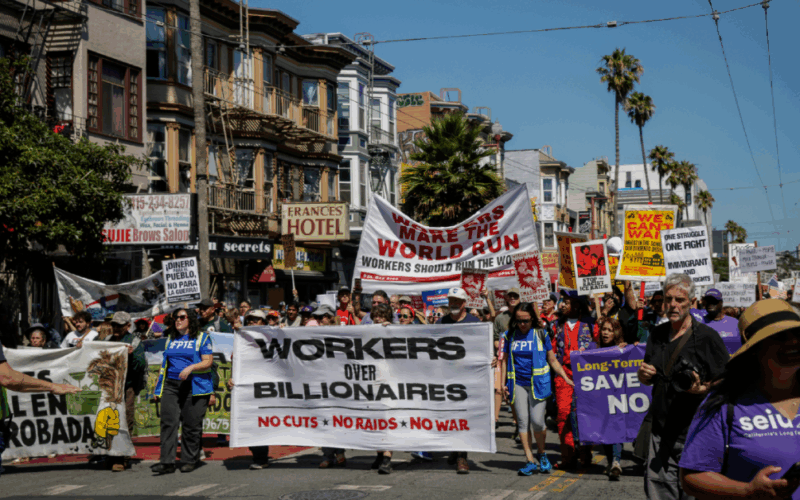United States – On Labor Day, thousands of protesters gathered in cities nationwide to voice their opposition to President Donald Trump and the undue influence of billionaires on American politics and the economy. Organized by May Day Strong, a coalition of labor and advocacy groups, the demonstrations spanned over 900 cities with more than 1,000 events held across the country.
The nationwide campaign, backed by the powerful AFL-CIO labor federation and titled “Workers over Billionaires”, brought together hundreds of thousands of participants rallying against what they call the growing power of wealthy elites during the second Trump administration.
A Nationwide Surge of Labor and Advocacy Protesters
The widespread protests captured attention in major metropolitan areas including New York, Chicago, Los Angeles, and Philadelphia, while smaller demonstrations erupted from Washington, D.C. to San Diego and as far as pockets of Florida and Idaho.
- May Day Strong spearheaded the effort, emphasizing the need to challenge the economic and political control of billionaires.
- The AFL-CIO’s involvement lent significant organizational strength and credibility to the movement.
- Organizers had anticipated several hundred thousand participants nationwide on this symbolic day for workers.
The group’s message, prominently displayed on their website, stated:
“Labor and community are planning more than a barbecue on Labor Day this year because we have to stop the billionaire takeover. Billionaires are stealing from working families, destroying our democracy, and building private armies to attack our towns and cities.”
Local Protests Highlight Distinct Regional Concerns
While united in core themes, specific local demonstrations also gave voice to unique regional issues. In Chicago, thousands opposed the Trump administration’s threats to increase National Guard presence and deploy federal immigration agents amid efforts to combat crime. Protesters chanted and held signs opposing the federal law enforcement surge, as reported by Reuters.
Meanwhile, in San Francisco, the local AFL-CIO chapter focused on confronting technology firms like Palantir. The company has secured billions in federal contracts, advancing artificial intelligence initiatives during Trump’s second term, raising concerns over corporate influence and surveillance.
The White House Responds to Labor Day Protests
In response to the protests, White House spokesperson Taylor Rogers emphasized President Trump’s commitment to American workers. Rogers stated,
“No one has done more for working men and women than President Trump. President Trump believes that American workers are the heart and soul of our economy, which is why he’s championed an agenda that always puts them first — from signing the largest middle-class tax cuts in history to securing nearly $10 trillion in new investments to create high-paying jobs across our country.”
Implications for Labor and Political Movements
This Labor Day mobilization reflects escalating tensions between labor advocates and corporate interests under the current administration. The massive scale and coordination of these protests indicate growing grassroots concerns over economic inequality and political influence favoring the ultra-wealthy.
- The coalition’s strategic focus on billionaires aims to spotlight wealth concentration and its impact on working families.
- It potentially sets the stage for continued activism and legislative proposals prioritizing labor rights and economic justice.
- The diverse locales of protest demonstrate the widespread dissatisfaction across urban centers and smaller communities alike.




